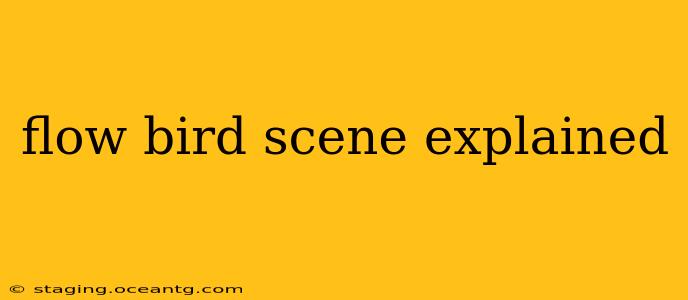The "flow bird" scene, typically referring to a specific, visually stunning moment in a film or animation, has captured the imaginations of many. While the exact source may vary depending on the context (it's less a specific scene and more of a stylistic trope), the core essence remains consistent: a breathtaking, almost dreamlike sequence showcasing fluid movement, often involving birds in flight. This exploration will dissect the common elements of these scenes and delve into why they resonate so deeply with audiences. We'll also address some frequently asked questions surrounding these captivating moments.
What Makes a "Flow Bird" Scene So Appealing?
The beauty of a "flow bird" scene transcends simple aesthetics. It's a powerful combination of several visual and emotional elements:
-
Fluid Motion: The key ingredient is the graceful, seemingly effortless movement of the birds. Their flight is often depicted with a sense of balletic precision, showcasing both individual agency and collective harmony. The camera work usually complements this, employing smooth tracking shots and slow-motion to emphasize the fluidity.
-
Visually Striking Imagery: These scenes often feature vibrant colors, stunning landscapes, and dramatic lighting. The combination creates a visually captivating experience that lingers in the viewer's memory. The birds themselves are sometimes stylized or otherworldly, adding to the dreamlike quality.
-
Emotional Resonance: The scenes often evoke feelings of freedom, wonder, and tranquility. The birds’ flight represents a sense of escape, a release from the constraints of the everyday world. This emotional connection is what makes the scenes truly memorable.
-
Symbolic Significance: The birds often serve as symbols of hope, transformation, or spiritual awakening. Their soaring flight can represent the journey of the characters or the overall theme of the story. This adds depth and complexity to the scene, moving beyond simple visual spectacle.
What are some examples of Flow Bird Scenes in Popular Culture?
While pinpointing a single definitive "flow bird scene" is difficult, many films and animations have employed similar stylistic choices. Think of scenes showcasing flocks of birds in films like Finding Nemo or animations like Spirited Away. These aren't just random bird flocks; they're orchestrated displays of movement and beauty integral to the narrative or atmosphere. The visual style emphasizes the elegance and fluidity of the birds' flight, creating a sense of awe and wonder.
How do "Flow Bird" Scenes Affect the Narrative?
These scenes aren't mere visual distractions; they serve a crucial narrative function:
-
Establishing Mood and Tone: They can set the overall mood of the film or a particular scene, influencing the viewer's emotional response. A peaceful flow bird scene might indicate a moment of calm reflection, while a more frantic one could foreshadow danger or conflict.
-
Transitioning Between Scenes: They often act as transitions between different narrative points, bridging disparate moments or themes. The smooth movement of the birds mirrors a smooth shift in the storyline.
-
Reflecting Character Arcs: The birds' flight can symbolically represent a character's inner journey or transformation. The scene's visual energy can reflect their own emotional state or goals.
Why are "Flow Bird" Scenes so Memorable?
The combination of stunning visuals, emotional resonance, and effective storytelling makes these scenes unforgettable. They tap into our innate appreciation for beauty and nature, creating a lasting impression long after the film or animation has ended. The scenes transcend simple entertainment; they become poignant moments that connect with the viewer on a deeper level.
What techniques are used to create realistic flow bird scenes?
Creating realistic and engaging flow bird scenes often involves a combination of techniques:
-
Advanced animation software: Software like Maya and Houdini allow animators to simulate realistic flocking behavior, creating dynamic and believable movements of large groups of birds.
-
Motion capture: While less common for birds specifically, motion capture technology can be used to record the movements of real birds or other animals, providing a basis for realistic animation.
-
Procedural generation: Algorithms can generate the movement patterns of individual birds, ensuring that the flock behaves naturally and avoids unnatural repetition.
This exploration of the "flow bird" scene offers a glimpse into its visual impact and underlying narrative power. These scenes are more than just pretty pictures; they're carefully crafted cinematic moments that deeply connect with the audience's emotions and sensibilities.
